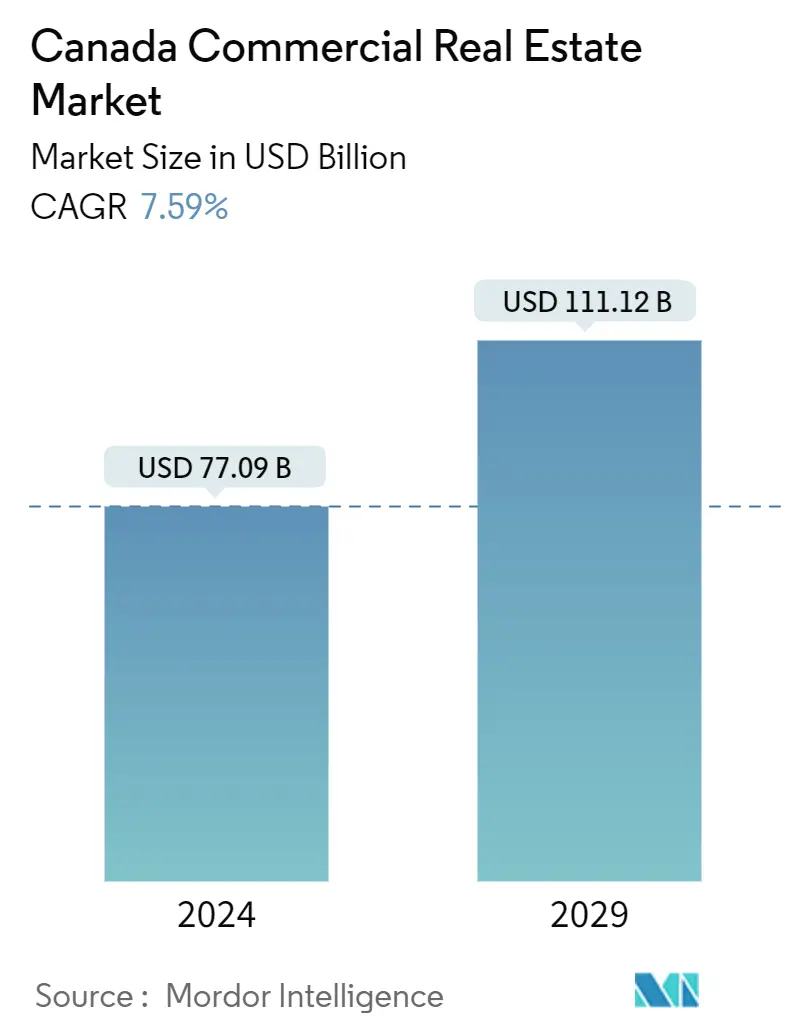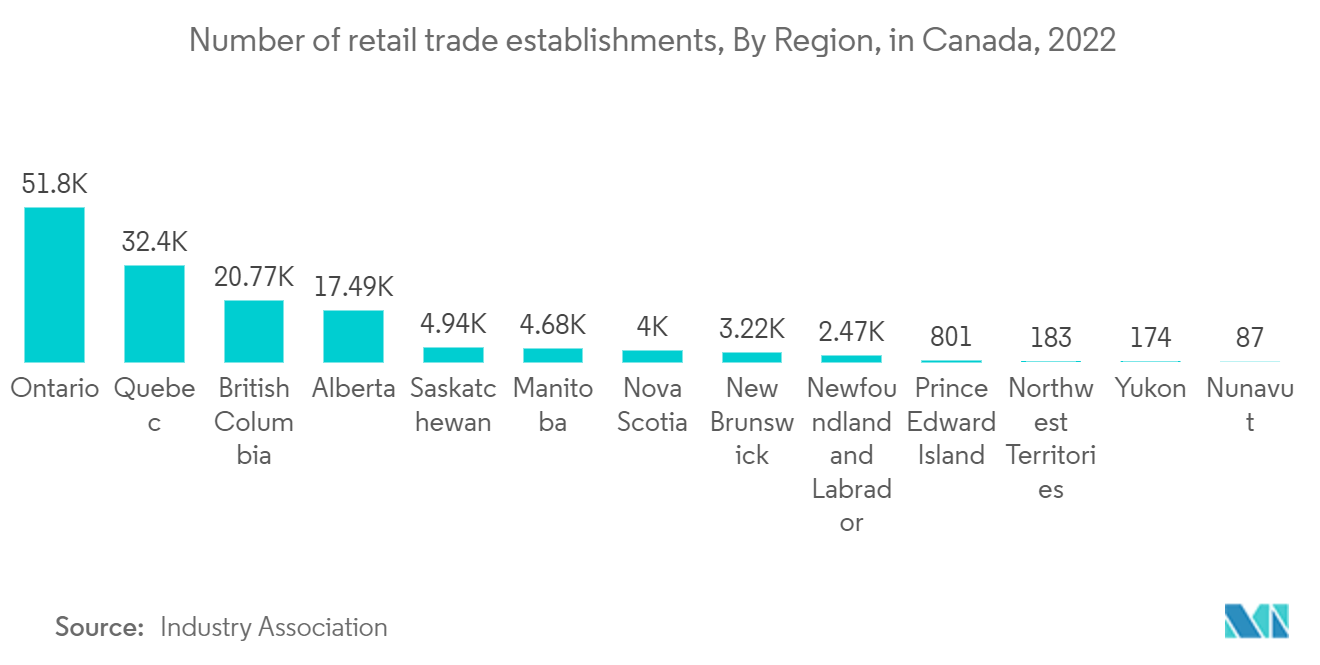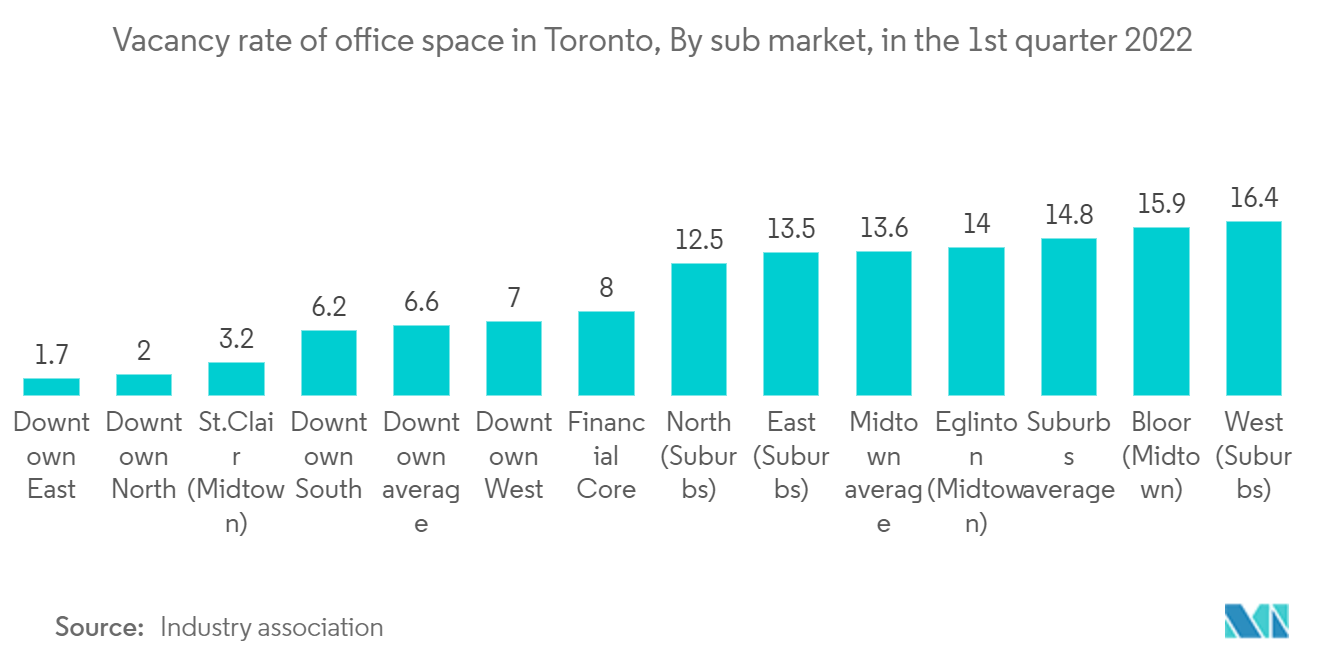Canada Commercial Real Estate Market Size

| Study Period | 2019 - 2029 |
| Base Year For Estimation | 2023 |
| Market Size (2024) | USD 77.09 Billion |
| Market Size (2029) | USD 111.12 Billion |
| CAGR (2024 - 2029) | 7.59 % |
| Market Concentration | Low |
Major Players.webp)
*Disclaimer: Major Players sorted in no particular order |
Canada Commercial Real Estate Market Analysis
The Canada Commercial Real Estate Market size is estimated at USD 77.09 billion in 2024, and is expected to reach USD 111.12 billion by 2029, growing at a CAGR of 7.59% during the forecast period (2024-2029).
Commercial real estate in Canada has witnessed tremendous growth and strong performance over the past thirty years. Industry participants have enjoyed outstanding possibilities for investment, asset development, service development, and property management.
However, the COVID-19 pandemic altered the real estate market's environment in Canada. The global cascade of corporate closures, restricted borders, and reduced spending habits affected investors, landlords, and tenants. They monitored the effects of COVID-19 and dynamically adjusted their operations and backup plans to support their operations and personnel on a daily basis.
In actuality, there is a direct link between population, employment, and real estate performance growth. The need for space grows along with a company's growth and expansion, and so does the cost of real estate to accommodate the addition of new personnel, goods, or services. Over the past thirty years, demand and space absorption have largely stayed positive in the office and industrial sectors.
Other elements that contribute to the expanding productivity gap include Canadian businesses' propensity to avoid competition, which is demonstrated by their comparatively low export intensity in comparison to other nations. Canada invests less in ICT than other developed nations in the mining, oil and gas, manufacturing (a proxy for industrial space), and banking (a proxy for office space) industries, three key contributors to our economy.
Several American firms, including Costco, Home Depot, Walmart, Apple, and others, have opened up shop in Canada. In order to stay competitive, Canadian merchants have been compelled to invest in their business models. The impressive legacy Additionally sold to American investors, Hudson's Bay Company is now gaining market share as a result of the increased investment and rivalry. As a result, this industry's production and retail spending have both increased significantly.
As technology improves the "path to purchase" for customers and the retail experience, store measurements continue to change. Mobile price monitoring is posing a competitive threat by minimizing the need for store visits and in-store transactions. In reaction to this trend, every store is uniquely realigning its portfolios. For instance, Staples is modifying their business strategy to emphasize e-commerce more. To guarantee that their Canadian footprint is optimized, other retailers are also reviewing their shop strategies.
Canada Commercial Real Estate Market Trends
Evolution of retail sector driving the market
The demand for products entering the Canadian market has increased due to the recent decade's robust retail expansion. The majority of the big retailers have acquired or built sophisticated new centers that can satisfy the "just-in-time" requirement of growing retail platforms, which has contributed to the booming storage and distribution business.
Demand often equals new space building because our industrial space is typically given to the market just in time. Because of the rush by investors and developers to secure these highly sought-after long-term tenants and space users, this has boosted market activity.
Because of the rush by investors and developers to secure these highly sought-after long-term tenants and space users, this has boosted market activity. Vacancy rates are lower in Toronto than they are in the majority of the US, a market that is expanding quickly. Other Canadian markets have different rates, with the national average coming in at just over 6%, which is slightly more than what members like.
Although asking rents have grown significantly, effective retail rentals have yet to make any headway toward catching up to inflation. Only a slight rise in average rental rates has been observed. While Vancouver continues to lead the pack in terms of rental rate appreciation, closely followed by Toronto, Calgary is finally returning to pre-pandemic levels.

Office spaces in Toronto and Vancouver are increasing
Office occupancy rates in downtown Toronto and Vancouver are rising swiftly. The third quarter of 2022 saw Canadian office markets continue to grow, with CBRE's new Q3 Figures report providing signs of growth in downtown areas despite resurgent demand for premium office space.
According to industry experts, Canadian office markets have proven extraordinarily resilient despite years of pandemic-related obstacles, new supply additions, persistent remote work issues, as well as a pending economic recession.
These most recent statistics provide solid proof that cities' vitality and momentum are returning, supporting increased leasing activity. Despite the fact that the economy is the center of attention, it is proving to be harder to anticipate than normal.
Indian IT service business Mphasis chose Calgary's First Tower as the location for its brand-new 26,160 square-foot Canadian headquarters. Microsoft secured a deal for about 400,000 square feet at the B6 building in Vancouver (1090 W Pender Street).
In the meantime, Toronto saw medical technology vendor PointClickCare increase its presence by acquiring 90,000 square feet over three floors at The Well, one of the most well-known new complexes in the city.
In 2022 Q3, downtown vacancy decreased in seven of Canada's ten major office cities, while suburban vacancy decreased in five of those markets. In the midst of a flurry of leasing transactions, Calgary, Waterloo Region, and Vancouver all saw their downtown and suburban office vacancy rates decline, making them the actual MVPs of the quarter.

Canada Commercial Real Estate Industry Overview
The Canadian commercial real estate market is fragmented, with local and few international players. The Canadian commercial real estate market is attracting many investments supported by an increasing number of real estate acquisitions and an increase in new property builders. Some leading Canadian commercial real estate players include Onni Group, WestBank Corp., Amacon Developers, and Maxwell Realty.
Canada Commercial Real Estate Market Leaders
-
Onni Group
-
Amacon
-
Pinnacle International
-
Maxwell Realty
-
Manulife Real Estate
*Disclaimer: Major Players sorted in no particular order

Canada Commercial Real Estate Market News
- June 2023: Prologis, Inc. and Blackstone announced a definitive agreement for Prologis to acquire nearly 14 million square feet of industrial properties from opportunistic real estate funds affiliated with Blackstone for USD 3.1 billion, funded by cash. The acquisition price represents an approximately 4% cap rate in the first year and a 5.75% cap rate when adjusting to today's market rents.
- May 2023: An experiential real estate investment trust, VICI Properties Inc., announced that it had signed agreements to buy the real estate assets of Century Casinos, Inc.'s Century Downs Racetrack and Casino in Calgary, Alberta, Century Casino St. Albert in Edmonton, Alberta, and Century Casino St. Albert in St. Albert, Alberta, for a total purchase price of USD 164.7 million. This move demonstrates both their continued drive to grow abroad and their faith in the Canadian gaming industry. They are also excited to assist Century's asset monetization strategy, which will open up new opportunities for their cooperation.
Canada Commercial Real Estate Market Report - Table of Contents
1. INTRODUCTION
- 1.1 Study Assumptions
- 1.2 Scope of the Study
2. RESEARCH METHODOLOGY
3. EXECUTIVE SUMMARY
4. MARKET INSIGHTS
- 4.1 Current Economic Scenario and Consumer Sentiment
- 4.2 Commercial Real Estate Buying Trends - Socioeconomic and Demographic Insights
- 4.3 Government Initiatives, Regulatory Aspects for the Commercial Real Estate Sector
- 4.4 Insights on Existing and Upcoming Projects
- 4.5 Insights on Interest Rate Regime for General Economy, and real estate lending
- 4.6 Insights on rental yields in commercial real estate segment
- 4.7 Insights on capital market penetration and REIT presence in commercial real estate
- 4.8 Insights on public-private partnerships in commercial real estate
- 4.9 Insights on real estate tech and startups active in real estate segment (broking, social media, facility management, and property management)
- 4.10 Impact of COVID-19 on the market
5. MARKET DYNAMICS
-
5.1 Drivers
- 5.1.1 Evolution of retail sector driving the market
- 5.1.2 Office spaces in Toronto and Vancouver are increasing
-
5.2 Restraints
- 5.2.1 High interest rates tend to slowdown business growth
- 5.2.2 Increasing cost of real estate affecting the growth of the market
-
5.3 Opportunities
- 5.3.1 Increasing demand from international buyers
- 5.3.2 Digitization of properties contributing to the growth of the market
-
5.4 Industry Attractiveness-Porter's Five Forces Analysis
- 5.4.1 Bargaining Power of Suppliers
- 5.4.2 Bargaining Power of Consumers / Buyers
- 5.4.3 Threat of New Entrants
- 5.4.4 Threat of Substitute Products
- 5.4.5 Intensity of Competitive Rivalry
6. MARKET SEGMENTATION (Market Size By Value)
-
6.1 By Type
- 6.1.1 Office
- 6.1.2 Retail
- 6.1.3 Industrial
- 6.1.4 Multi-family
- 6.1.5 Hospitality
-
6.2 By Key Cities
- 6.2.1 Toronto
- 6.2.2 Vancouver
- 6.2.3 Calgary
- 6.2.4 Ottawa
- 6.2.5 Montreal
- 6.2.6 Edmonton
- 6.2.7 Rest of Canada
7. COMPETITIVE LANDSCAPE
- 7.1 Market Concentration
-
7.2 Company Profiles
- 7.2.1 Developers
- 7.2.1.1 Onni Group
- 7.2.1.2 WestBank Corp.
- 7.2.1.3 Amacon
- 7.2.1.4 Pinnacle International
- 7.2.1.5 Anthem Properties Group Limited
- 7.2.1.6 Knights Bridge Development Corp.
- 7.2.1.7 Chard Development
- 7.2.1.8 TAG Developments
- 7.2.1.9 Goodman Commercial
- 7.2.1.10 Redev Properties*
- 7.2.2 Real Estate Brokerage Firms
- 7.2.2.1 Manulife Real Estate
- 7.2.2.2 Harvey Kalles Real Estate
- 7.2.2.3 Maxwell Realty*
- 7.2.3 Other Companies (startups, associations, etc.)
- 7.2.3.1 Brookfield Global Integrated Solutions
- 7.2.3.2 Relogix
- 7.2.3.3 Realtor 360
- 7.2.3.4 Hausway
- 7.2.3.5 Dream Office REIT
- 7.2.3.6 Cominar REIT
- 7.2.3.7 Allied REIT*
- *List Not Exhaustive
8. FUTURE OF THE MARKET
9. INVESTMENT ANALYSIS
10. APPENDIX
** Subject To AvailablityCanada Commercial Real Estate Industry Segmentation
Commercial real estate (CRE) is a property used exclusively for business-related purposes or to provide a workspace rather than as a living space. Commercial real estate is often leased to tenants to conduct income-generating activities. This broad real estate category can include everything from a single storefront to a huge shopping center.
The Canadian commercial real estate market is segmented by type (office, retail, industrial, multi-family, and hospitality) and by city (Toronto, Vancouver, Calgary, Ottawa, Montreal, and Edmonton, as well as other cities).
The report offers market size and forecasts for the commercial real estate market in Canada in terms of value (USD) for all the above segments.
| By Type | Office |
| Retail | |
| Industrial | |
| Multi-family | |
| Hospitality | |
| By Key Cities | Toronto |
| Vancouver | |
| Calgary | |
| Ottawa | |
| Montreal | |
| Edmonton | |
| Rest of Canada |
Canada Commercial Real Estate Market Research Faqs
How big is the Canada Commercial Real Estate Market?
The Canada Commercial Real Estate Market size is expected to reach USD 77.09 billion in 2024 and grow at a CAGR of 7.59% to reach USD 111.12 billion by 2029.
What is the current Canada Commercial Real Estate Market size?
In 2024, the Canada Commercial Real Estate Market size is expected to reach USD 77.09 billion.
Who are the key players in Canada Commercial Real Estate Market?
Onni Group, Amacon, Pinnacle International, Maxwell Realty and Manulife Real Estate are the major companies operating in the Canada Commercial Real Estate Market.
What years does this Canada Commercial Real Estate Market cover, and what was the market size in 2023?
In 2023, the Canada Commercial Real Estate Market size was estimated at USD 71.24 billion. The report covers the Canada Commercial Real Estate Market historical market size for years: 2019, 2020, 2021, 2022 and 2023. The report also forecasts the Canada Commercial Real Estate Market size for years: 2024, 2025, 2026, 2027, 2028 and 2029.
Which types of Commercial Estate are considered in the Canada Commercial Real Estate Market report?
Office, retail, industrial, multi-family, and hospitality are the various types of commercial real estate considered in the Commercial Real Estate Market report.
Canada Commercial Real Estate Industry Report
The Canada Commercial Real Estate market, particularly in Toronto, is projected to experience significant growth driven by a stable economy, low-interest rates, and urbanization. Customers are increasingly prioritizing modern, sustainable properties that emphasize energy efficiency and technology integration. The rise of mixed-use developments, blending commercial, residential, and retail spaces, is a key market trend. Additionally, there is an increasing demand for office spaces in major cities like Toronto.
The market varies across different regions, each with unique economic drivers and market dynamics. Alberta's market is influenced by the oil and gas industry, while Ontario's market, including Toronto, is driven by the financial services and technology sectors. The market's growth can be attributed to several underlying macroeconomic factors, such as a skilled workforce, political stability, and a robust financial system. Government initiatives and policies, particularly in housing, energy efficiency, and sustainable development, also influence the market.
The office real estate sector in Toronto is expected to drive market growth due to low office vacancy rates, while the industrial sector is emerging as the fastest-growing segment due to increasing warehouse space demand. The Canada Commercial Real Estate market is segmented by type and by city, offering market size and forecasts in terms of value for all segments. The industry outlook is positive, supported by industry statistics and market size data.
Market analysis reveals that the industry is poised for expansion, with market research highlighting the importance of energy efficiency and technology integration in properties. The market forecast indicates continued growth, driven by the demand for mixed-use developments and office spaces. Industry reports provide valuable insights, with market data supporting the optimistic market outlook.
The market overview shows a diverse landscape, influenced by regional economic drivers and macroeconomic factors. Market predictions suggest sustained growth, with market segmentation highlighting the varying needs across different regions. The industry analysis underscores the importance of government policies in shaping the market, while industry trends point to the increasing demand for sustainable and technologically advanced properties.
Industry research and market review further emphasize the significance of these trends, with industry sales and market value reflecting the growing demand. Report examples and report PDFs offer detailed insights into the market dynamics, supported by research companies' findings. The market leaders are adapting to these trends, ensuring their properties meet the evolving needs of customers.



